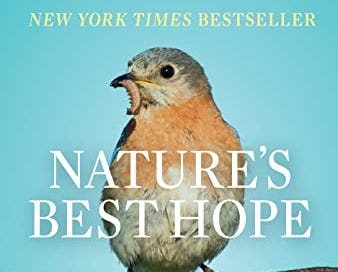Howdy readers,
Earlier this year I wrote about Jenny Odell’s outstanding book How to Do Nothing, which ignited the desire to take up “bird noticing1.” This week I’m talking about a book that is the next step on my bird noticing journey.
It’s called Nature’s Best Hope: A New Approach To Conservation That Starts in Your Yard by Douglas W. Tallamy and it inspired me as a homeowner in the suburbs to get involved in conservation using a method that’s completely new to me. Let’s jump in!
I was immediately taken in by the main premise: Conservation and sustainability must take place on private property. For the longest time I thought conservation meant composting, conserving water, never washing my jeans, cold showers, and trying to reduce my carbon footprint. Tallamy argues that there is more to sustainability. Your yard — the land you own and live on — is only sustainable if it is capable of sustaining life. Conserving water and energy are worthy goals, but conserving life must also be a priority.
If conservation is to happen, it must happen largely on private property, but not just on farms and ranches; it must include all types of private property, from the smallest city lot to the largest corporate landscape.
For Tallamy, no amount of private property is too small to practice what he preaches, which is creating a “Homegrown National Park” by replacing 50% of your lawn with native plants. Turf grass, while attractive, doesn’t support enough life. The birds that are migrating and reproducing in your area get energy from worms dense in nutrients, and those worms are adapted to eating native plants. To have a thriving bird community, you need a thriving worm community and to have a thriving worm community, you need native plants.
Which is why this feels like the next step in bird watching — rather than hoping the birds show up, I can landscape with native plants and bring the birds to me.
I have no idea if I have it in me to reduce my lawn by 50% — we enjoy playing soccer and baseball in the backyard and I’m a little ashamed to admit that I love a lush, green lawn. Plus, what will the HOA say? Rather than going all in on turf replacement, I plan to take Tallamy’s advice to hesitant homeowners by starting small; next spring I’ll test out some native plants in our garden areas and see how it goes.
Native plants don’t just bring the worms and birds - they require less water than grass and help the pollinators which are essential to life on earth. Wins all around.
Others are thinking about this topic and there are resources for finding plants native to your area. The National Wildlife Federation has a native plant finder and Audobon.org has a site for finding native plants for birds.
Overall, I recommend the book to those interested in the topic and need a push to get started. Even if you only read the final chapter, titled “What Each of Us Can Do,” you’ll get useful tips and advice.
Thanks for reading,
Kyle
In addition to bird watching, bird noticing involves identifying birds by their calls and songs.





Please do. Biodiversity is very important :)
Godspeed on your native planting venture! I hadn't thought about this level of sustainable living or the point of sustainable LIFE. Appreciate you bringing this into my thought process! My challenge will be applying the idea to condo living.